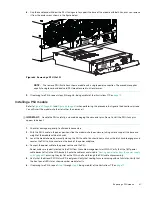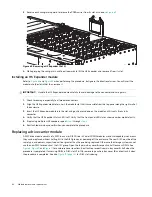
Fault isolation methodology
75
Thermal monitoring and control
The storage enclosure system uses extensive thermal monitoring and takes a number of actions to ensure component
temperatures are kept low, and to also minimize acoustic noise. Air flow is from the front to back of the enclosure.
Thermal alarm
Fault isolation methodology
This section presents the basic methodology used to locate faults within a storage system, and to identify the pertinent
FRUs affected.
Basic steps
•
Gather fault information, including using system LEDs.
•
Determine where in the system the fault is occurring.
•
Review logs from the host application/operating system.
•
Review Ddump output from both controllers:
The
Ddump
CLI command is described in the GEM Command-line Interface document.
Symptom
Cause
Recommended action
If the ambient air is below 25ºC
(77ºF), and the fans are
observed to increase in speed,
then some restriction on airflow
may be causing additional
internal temperature rise.
NOTE:
This is not a fault
condition.
The first stage in the thermal
control process is for the fans to
automatically increase in speed
when a thermal threshold is
reached. This may be caused by
higher ambient temperatures in
the local environment, and may
be perfectly normal.
NOTE:
This threshold changes
according to the number of drives
and power supplies fitted.
1.
Check the installation for any airflow
restrictions at either the front or back of the
enclosure. A minimum gap of 25 mm (1") at
the front and 50 mm (2") at the rear is
recommended.
2.
Check for restrictions due to dust build-up.
Clean as appropriate.
3.
Check for excessive re-circulation of heated
air from rear to front. Use of the enclosure in
a fully enclosed rack is not recommended.
4.
Verify that all blank modules are in place.
5.
Reduce the ambient temperature.
Symptom
Cause
Recommended action
1.
Front panel Module Fault
LED is amber.
2.
Fan Fail LED is illuminated
on one or more fans.
Internal temperature exceeds a
preset threshold for the
enclosure.
1.
Verify that the local ambient environment
temperature is within the acceptable range.
See also
.
2.
Check the installation for any airflow
restrictions at either the front or back of the
enclosure. A minimum gap of 25 mm (1") at
the front and 50 mm (2") at the rear is
recommended.
3.
Check for restrictions due to dust build-up.
Clean as appropriate.
4.
Check for excessive re-circulation of heated
air from rear to front. Use of the enclosure in
a fully enclosed rack is not recommended.
5.
If possible, shut down the enclosure and
investigate the problem before continuing.
















































